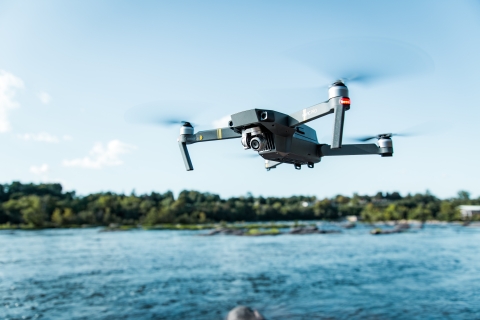

Researchers at the University of Portsmouth have teamed-up with the United Nations World Food Programme to use drones to help rescue people in the aftermath of natural disasters
9 June 2022
6 min read
The University of Portsmouth has helped organise the UK’s first post-disaster search and rescue experiment for drone applications, as part of its ongoing collaboration with the UN World Food Programme WFP.
Using search-drones in emergency situations such as floods, droughts, storms or earthquakes, enables helicopters and planes to be re-deployed for rescuing people and delivering essential aid. Drones also have low operating costs and can be deployed quickly, even in difficult weather conditions, but little is known about the most effective ways to use them over large areas.
The UN WFP has been developing the use of Uncrewed Aircraft Systems since 2017 to improve responses to humanitarian crises, encouraging collaboration among first responders and government stakeholders worldwide.
In November, University of Portsmouth researchers played a key role in a flood disaster simulation based around a lake in Mozambique. Using drones they searched for volunteers who needed rescuing, as well as locating local hazards, such as crocodiles.
Data processing and applications of satellite technology is being led by Professor Richard Teeuw from the Centre for Applied Geosciences at the University. He said: “The University of Portsmouth has been running training courses in Crisis and Disaster Management for over 10 years, with annual emergency response simulation events.
“It also hosts a centre of excellence for space technology applications, including drones, so this research with the United Nations, into ways of using drones to save lives during disasters, is an effective partnership.”
During the experiment in Salisbury, participants tested various types of drone survey technologies, from colour photos to thermal infra-red images, looking for more effective ways to find people. Local volunteers from ServeOn and UK Lowland Rescue have joined in the UK.
The University of Portsmouth has been running training courses in Crisis and Disaster Management for over 10 years
Dr Richard Teeuw, Professor of Geoinformatics and Disaster Risk Reduction
WFP Drones Team Project Manager, Elizabeth Bourke, said: “In the first phase in Mozambique we already made some valuable findings on how to most effectively use drones in a wide area search to find the location of people needing rescue. In this second phase, we are focusing on the use of machine learning to even more rapidly detect people in a large-scale emergency.
“Through our collaboration with the University of Portsmouth we're working to develop these tools as well as a set of best practice and Standard Operating Procedure documents to guide future emergency teams to most effectively identify the location of people needing rescue. Doing that will mean we can use the rescue helicopters and boats more efficiently and ultimately save more lives.”
Lead drone pilot at the University of Portsmouth, Toby Meredith, added: "Managing a large scale project of this type has many safety complexities due to the number of drones in use. We've been able to provide the safety support to ensure all our international, and national pilots, can carry out their missions with minimum risk. Additionally, the safety protocols we have developed at UoP has meant that all UK CAA regulations have been adhered to."
This experiment, known as ‘Procurar’, forms part of a research project that has been funded by the European Civil Protection and Humanitarian Aid Operations (ECHO), and is managed by the United Nations World Food Programme’s Drone Hub in Johannesburg. All phases of the project known as ‘Procurar’, are a collaboration between the UN World Food programme, Institute of Search and Technical Rescue and the University of Portsmouth.
We're working to develop a set of best practice and Standard Operating Procedure documents to guide future emergency teams to most effectively identify the location of people needing rescue
Elizabeth Bourke, WFP Drones Team Project Manager
This year the team ran a follow-on experiment at a former RAF base in the Chilmark area, near Salisbury. The six-day event, funded by the EU through the WFP took place from Thursday 9 to Tuesday 14 June, and welcomed around 20 drone pilots from Africa, Europe, the UK, and Canada.
It involved placing human targets in a range of environments, and collecting images from drones at different heights and with a range of cameras. The images were then searched by computers or humans to try to detect those targets. This allowed a formula to be applied to those searches to calculate the effectiveness of the process.
The experiment has been designed by Dr Ian Greatbatch of the National Fire Chiefs Council, who is also a fellow of InSTR and a visiting researcher at the University of Portsmouth.
